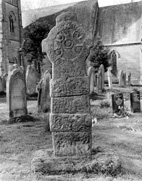Select a site alphabetically from the choices shown in the box below. Alternatively, browse sculptural examples using the Forward/Back buttons.
Chapters for this volume, along with copies of original in-text images, are available here.
Object type: Cross-shaft, -head and -base
Measurements:
Total height: 92 cm (36.25 in)
Head: H. 73 cm (28.75 in); W. 68 cm (26.75 in); D. 17.3 cm (6.8 in)
Shaft: H. (max.): 122 cm (48 in); W. 48 < 52 > 45 cm (19 < 20.5 > 17.7 in)
Upper collar: H. 23 cm (9 in); W. 53 cm (21 in); D. 25 cm (9.8 in)
Lower collar: H. 24 cm (9.5 in); W. 54.7 cm (21.5 in); D. 26 cm (10.25 in)
Stone type: Medium-grained, micaceous red sandstone (St Bees sandstone)
Plate numbers in printed volume: 539 - 42
Corpus volume reference: Vol 2 p. 143-145
(There may be more views or larger images available for this item. Click on the thumbnail image to view.)
Cross-head, type A9 with circle type 3, the arm-pits containing a boss; collared squarish shaft, type e. There are roll-moulded borders to all faces of the circle and cross-arms. The panels on the collars are fully framed, but other shaft panels lack a lower border. The plain base may be original.
A (broad): At the centre of the head is an encircled boss and there are further bosses in the unpierced arm-pits; all of these bosses carry a drilled hole. There are traces of interlace on the circle, on the arms lying within it, and (possibly) on the upper arm protruding above the circle.
There are five panels on the shaft below, two of them on the raised collars. (i) At the top is a panel of worn, irregular and unidentifiable interlace. (ii) On the upper collar is a fettered and enmeshed crouching animal. The beast has gaping fanged jaws with a twisted upper lip and there is an extension running along his back from the ear. There is no clear trace of a rear leg, but the single fore leg lies under the head. (iii) On the third panel there is interlace of an unidentifiable type. (iv) The lower collar carries the remains of a contoured ribbon animal, with gaping jaws surrounded by strands extending from head and tail. (v) The lowest panel probably contained interlace.
B (narrow): No ornament is visible on the head, though the circle carries a roll-moulded border and the arm-end is framed. The shaft below is divided into five panels, the uppermost, (i), being a continuation of the lower part of the circle, from which it is not divided. Ornament is now only visible on the panels above and below the collars (i and v), and consists of ring-chain derivative (G.I., fig. 26 cv).
C (broad): At the centre of the head is an encircled boss and there are smaller bosses set in the unpierced arm-pits. The smaller bosses carry a drilled hole. Interlace of unidentifiable type occupied the circle, the arms which lie within it, and the extended upper arm. The right hand border moulding of the upper arm seems to pass over the circle.
There are five panels on the shaft below. The decoration in the top panel, (i), is no longer recognizable but, on the raised collar below, (ii), there are the remains of a ribbon animal with gaping jaws, bound in interlace. There is interlace on the panel below, (iii), but the relief decoration of the other two panels (iv–v) is no longer clear.
D (narrow): The circle of the head is bound by a raised moulding, but no decoration is now visible either on the circle or on the end of the arm. On the shaft below are five panels, the uppermost, (i), representing a continuation of the circle. There is interlace of an unidentifiable type in (i) and ring-chain derivative (G.I., fig. 26 cv) in the central and bottom panels (iii and v), but the decoration on the collars is no longer distinguishable.
This circle-head is closely linked to an example from Bromfield (no. 2) with which it shares an identical squarish collared shaft along with an ornamental scheme which placed contoured ribbon animals on the broad raised collars and allocated ring-chain to panels on the narrow faces. Like Bromfield's animals, the beasts at Rockcliffe reflect the Jellinge style.
The manner in which the border moulding of one arm on face C overruns the circle is paralleled among the Chester group of circle-heads at Neston (Allen 1895, 170) and is another example of the interpenetration of motifs between the two circle-head groups, which perhaps implies that the Chester and Cumbrian crosses are contemporary with each other (Bailey 1980, 180). A similar phenomenon does, however, occur in the Isle of Man (Kermode 1907, no. 59). Uniquely among the Cumbrian circle-heads the arm-pits of this cross are not pierced but occupied by bosses, which are ornamented with drilled holes. Circle-heads in Cheshire and north Wales have bosses placed in the arm-pits in a manner which, at first sight, closely resembles Rockcliffe (Bu'lock 1958) and one of them even carries a drilled hole (Nash-Williams 1950, no. 190). But in all cases the Cheshire group have the boss set close against the central part of the head and not in the middle of the gap between the circle and the centre. It is probably more relevant, therefore, to remark that bossing of the Rockcliffe type does occur across the Solway in the Whithorn area on freestanding crosses (Collingwood 1922–3, pls. VII, VIII, XI) and that Rockcliffe was, in later medieval times, a point of embarcation for south-west Scotland (McIntire 1939). Some form of contact across the Solway seems the most likely explanation for this peculiar feature.
The animal forms and the Borre-derived ring-chain point to a tenth-century date.



